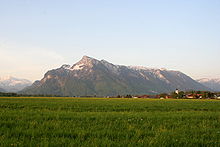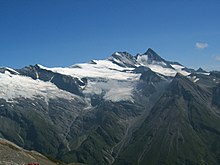Solid

Mont Ventoux , an elongated limestone massif in the Provencal pre-Alps, Vaucluse, France
|
Solid ( französ. Massif , "moderately", "compact") is a name for several large, compact, positive relief forms ( mountain range , mountain range or summit Stock and the like) and or or for specific areas on the Earth's surface, the geologically from their Clearly demarcate the surroundings.
General

Massifs are not organized as mountain ranges ( chain mountains ) and mountain ranges , but can be integrated into such. They are usually compact and bordered all around by valleys or valley pass trains or form a more or less completely free-standing geomorphological or at least geological unit.
In many cases, this morphological independence is also geologically founded, e.g. B. because the weathering behavior of the corresponding rocks differs from that of the surrounding rocks. Massives can have different tectonic or other prehistory. Rock bodies with steep geological boundaries are called stock . Cliffs are remnants of tectonic blankets that have been separated from their original rock formation by erosion . Broken clods are islands-like areas of the earth's crust that are tectonically raised from their surroundings . In some cases there are significant differences in the spatial extent. In addition, individual mountain massifs are often differentiated within a larger mountain range.
Massive in the predominantly geological sense


The great geological massifs of the earth always have a relatively high geological age and are remnants of former high mountains . One speaks here of mass mountains , rump mountains or basement massifs . If they form the oldest, tectonically inactive areas of a continent, they are also called shields . Today they reach a maximum of low mountain ranges . Basement massifs may previously have been largely leveled by erosion and only later lifted out again. Especially when they consist of metamorphic and igneous rocks, at least in temperate latitudes they hardly tend to form relief and tend to form hilly plateaus.
Examples of old rump mountains from pre-alpine times in Europe :
- Bohemian mass in Bohemia and northeastern Austria
- Massif Central in the south of France
- Rhenish Slate Mountains (Rheinische Masse)
- Harz including the Brocken massif (a large granite body)
In young fold mountains such as the Alps, there are often areas with old rocks that are geologically very similar to the basement massifs. These areas are also referred to as basement massifs, or in the western Alps, if they are autochthonous basement mountains of the Helveticum , also of massifs central (not to be confused with the Rump Mountains in France). B. the Mont-Blanc massif or the Gotthard massif , and in contrast to z. B. the Bohemian Massif, overlap relatively strongly with the concept of the mountain massif.
Mountain ranges

Individual, particularly conspicuous mountains or compact mountain groups are called mountain massifs or mountain ranges . They are characterized by steep flanks and sometimes form a plateau mountain with a furrowed high plateau or a table mountain with a plateau. The word is also used for massive, primarily stone volcanoes.
Most of the mountains labeled “Massif” include the relatively highest mountains - measured from their feet - in a region. In high mountains, notch heights of 300–500 m are the minimum for an independent mountain, the Mont Ventoux, for example, rises over 1600 m above the hills of the Rhône valley and has a corresponding notch height. This applies even more to volcanoes, such as the volcanic chain of East Africa with the Kilimanjaro massif as the "highest free-standing mountain in the world", Elbrus , or Mount St. Helens .
- See also: Highest Mountain
Examples:
-
Limestone are typical formations of relatively resistant limestones , partly and especially reef limestone :
- Mountains of the limestone Alps such as the Zugspitze , Dachstein massif , Hagengebirge , Tennengebirge , Vienna's local mountains Rax and Schneeberg in the Northern Alps; or the Marmolada in the Southern Alps, the Triglav Group in Slovenia, Vercors in eastern France; all with the typical, partly named Karst high plateaus ( Höllengebirge , Sengsengebirge , Steinernes Meer ) and often the missing main summit
- Several main peaks of the Central Alps
- Monte Rosa and Mont Blanc massif in the western Alps
- Famara massif in Lanzarote
- Gran Sasso massif in Italy
- Mount Kenya massif in Kenya
- Paekdu massif in Korea
- Ruwenzori massif in Uganda and the Republic of Congo
- Velebit massif in Croatia
Summit massifs
Summit formations in stick formation are common: the summit of the mountain then forms a form that is clearly separated from its main mass. The reason are resistant rocks in the summit area than at the foot of the mountain.
More extreme formations are called rock towers or battlements .
Mountain massifs as a motif in art
Since the mountain itself became a subject ( mountain painting ), painters and art photographers have chosen mountain ranges as their motifs . Their distinctive shapes are valued, especially those that have distinctly steep slopes and are easy to see from the valley. Thousands of paintings were created from Styria's local mountain Grimming , from the Dachstein massif , also by famous artists such as B. Gauermann . Motifs from the Bernese Alps (Eiger, Jungfrau etc.), from the Watzmannstock , from the Central German Harz Mountains or from the South Tyrolean Dolomites are also known, but also in Chinese painting , which has the mountain as a motif for its own sake since ancient times knows, and in modern Japanese art (like the 36 Views of Mount Fuji from Hokusai ). Famous places such as the Malerwinkel as well as the temples and pagodas on the sacred mountains of China, which suggest a very defined, particularly picturesque section of the landscape , show that the artists are drawn to very selected views of a mountain .
literature
- André Cailleux: The Unknown Planet: Anatomy of the Earth. Kindler's University Library, Munich 1968, chap. 1 and 3.
- Jonathan Weiner: Planet Earth. Droemer, Munich 1987.


